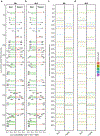Mass Spectrometry, Structural Analysis, and Anti-Inflammatory Properties of Photo-Cross-Linked Human Albumin Hydrogels
- PMID: 35544705
- PMCID: PMC9668369
- DOI: 10.1021/acsabm.2c00109
Mass Spectrometry, Structural Analysis, and Anti-Inflammatory Properties of Photo-Cross-Linked Human Albumin Hydrogels
Abstract
Albumin-based hydrogels offer unique benefits such as biodegradability and high binding affinity to various biomolecules, which make them suitable candidates for biomedical applications. Here, we report a non-immunogenic photocurable human serum-based (HSA) hydrogel synthesized by methacryloylation of human serum albumin by methacrylic anhydride (MAA). We used matrix-assisted laser desorption ionization-time-of-flight mass spectrometry, liquid chromatography-tandem mass spectrometry, as well as size exclusion chromatography to evaluate the extent of modification, hydrolytic and enzymatic degradation of methacrylated albumin macromer and its cross-linked hydrogels. The impacts of methacryloylation and cross-linking on alteration of inflammatory response and toxicity were evaluated in vitro using brain-derived HMC3 macrophages and Ex-Ovo chick chorioallantoic membrane assay. Results revealed that the lysines in HSA were the primary targets reacting with MAA, though modification of cysteine, threonine, serine, and tyrosine, with MAA was also confirmed. Both methacrylated HSA and its derived hydrogels were nontoxic and did not induce inflammatory pathways, while significantly reducing macrophage adhesion to the hydrogels; one of the key steps in the process of foreign body reaction to biomaterials. Cytokine and growth factor analysis showed that albumin-based hydrogels demonstrated anti-inflammatory response modulating cellular events in HMC3 macrophages. Ex-Ovo results also confirmed the biocompatibility of HSA macromer and hydrogels along with slight angiogenesis-modulating effects. Photocurable albumin hydrogels may be used as a non-immunogenic platform for various biomedical applications including passivation coatings.
Keywords: albumin; hydrogels; inflammatory pathways; mass spectrometry; non-immunogenic; photocurable gels; structural analysis.
Conflict of interest statement
Competing interests
Morteza Mahmoudi discloses that (i) he is a co-founder and director of the Academic Parity Movement (
Figures











Similar articles
-
Functionalisation of a heat-derived and bio-inert albumin hydrogel with extracellular matrix by air plasma treatment.Sci Rep. 2020 Jul 24;10(1):12429. doi: 10.1038/s41598-020-69301-7. Sci Rep. 2020. PMID: 32709918 Free PMC article.
-
Fructose-human serum albumin interaction undergoes numerous biophysical and biochemical changes before forming AGEs and aggregates.Int J Biol Macromol. 2018 Apr 1;109:896-906. doi: 10.1016/j.ijbiomac.2017.11.069. Epub 2017 Nov 11. Int J Biol Macromol. 2018. PMID: 29133088
-
Photocurable Albumin Methacryloyl Hydrogels as a Versatile Platform for Tissue Engineering.ACS Appl Bio Mater. 2020 Feb 17;3(2):920-934. doi: 10.1021/acsabm.9b00984. Epub 2020 Jan 13. ACS Appl Bio Mater. 2020. PMID: 35019294
-
Hydrogels as Antibacterial Biomaterials.Curr Pharm Des. 2018;24(8):843-854. doi: 10.2174/1381612824666180213122953. Curr Pharm Des. 2018. PMID: 29436994 Review.
-
Genipin-cross-linked hydrogels based on biomaterials for drug delivery: a review.Biomater Sci. 2021 Mar 10;9(5):1583-1597. doi: 10.1039/d0bm01403f. Biomater Sci. 2021. PMID: 33443245 Review.
Cited by
-
Multifaceted Proteome Analysis at Solubility, Redox, and Expression Dimensions for Target Identification.Adv Sci (Weinh). 2024 Oct;11(38):e2401502. doi: 10.1002/advs.202401502. Epub 2024 Aug 9. Adv Sci (Weinh). 2024. PMID: 39120068 Free PMC article.
-
Leveraging 3D Bioprinting and Photon-Counting Computed Tomography to Enable Noninvasive Quantitative Tracking of Multifunctional Tissue Engineered Constructs.Adv Healthc Mater. 2023 Dec;12(31):e2302271. doi: 10.1002/adhm.202302271. Epub 2023 Sep 25. Adv Healthc Mater. 2023. PMID: 37709282 Free PMC article.
-
Amyloid-Based Albumin Hydrogels.Adv Healthc Mater. 2023 Mar;12(7):e2201748. doi: 10.1002/adhm.202201748. Epub 2022 Dec 18. Adv Healthc Mater. 2023. PMID: 36469813 Free PMC article.
-
Research progress on albumin-based hydrogels: Properties, preparation methods, types and its application for antitumor-drug delivery and tissue engineering.Front Bioeng Biotechnol. 2023 Apr 11;11:1137145. doi: 10.3389/fbioe.2023.1137145. eCollection 2023. Front Bioeng Biotechnol. 2023. PMID: 37113668 Free PMC article. Review.
-
Evaluating the Effects of BSA-Coated Gold Nanorods on Cell Migration Potential and Inflammatory Mediators in Human Dermal Fibroblasts.J Funct Biomater. 2024 Sep 26;15(10):284. doi: 10.3390/jfb15100284. J Funct Biomater. 2024. PMID: 39452583 Free PMC article.
References
-
- Drury JL; Mooney DJ, Hydrogels for tissue engineering: scaffold design variables and applications. Biomaterials 2003, 24 (24), 4337–4351. - PubMed
-
- Gyles DA; Castro LD; Silva JOC; Ribeiro-Costa RM, A review of the designs and prominent biomedical advances of natural and synthetic hydrogel formulations. European Polymer Journal 2017, 88, 373–392.
-
- Madduma-Bandarage USK; Madihally SV, Synthetic hydrogels: Synthesis, novel trends, and applications. Journal of Applied Polymer Science 2021, 138 (19), 50376.
Publication types
MeSH terms
Substances
Grants and funding
LinkOut - more resources
Full Text Sources
Other Literature Sources
